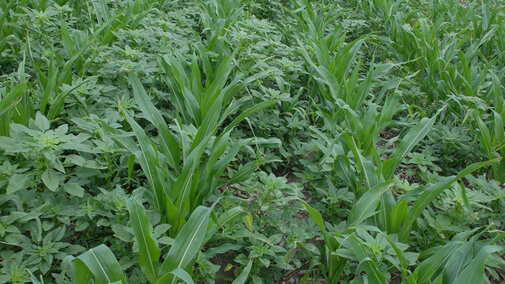This week several farmers contacted Nebraska Extension Weed Scientist Amit Jhala with questions about the reduced herbicide effectiveness they were seeing in some fields and whether it might be due to a new pesticide resistance. Following is one of the questions and Jhala’s response.
Farmer Question:
I applied .7 oz/acre Cadet plus 36 oz/acre of Roundup Powermax + 48 oz/acre Warrant to soybeans on June 8. The Palmer Amaranth did not die and is really growing fast. Presently the largest weeds are about 4 inches tall. Most are less than that. Most of it seemed unaffected by herbicide. The soybeans seemed to be burned more than the weeds. Palmer amaranth is the only weed present. I ran the pivot on .65 inch to activate Warrant, but dryland areas received no rainfall to activate the herbicide. The worst spots are at the ends of the field. I may just treat the borders with Ultra Blazer or Cobra and then rogue the larger part of the field if a few scattered ones show up. Any suggestions for the best control with least amount of damage to soybeans?
Answer from Amit Jhala, Nebraska Extension Weeds Specialist:
If you have applied glyphosate at 36 fl oz/acre with labeled adjuvants when Palmer amaranth was less than 3 inches and were not able to control Palmer amaranth, the Palmer amaranth is suspected to be resistant to glyphosate. Cadet is a PPO-inhibiting herbicide and likely responsible for the injury on soybean. In most cases, the injury from a PPO-inhibiting herbicide is cosmetic and will not have a yield penalty. Warrant is a residual herbicide and would need some moisture to activate.
Glyphosate-resistant Palmer amaranth is difficult to control with post-emergence herbicides in Roundup Ready soybean. The only effective option now is to use additional PPO inhibitors such as Cobra, Marvel, or Ultra Blazer. Remember that they are also PPO-inhibitors and likely to cause some level of injury similar to what you have observed with Cadet.
What can be done to reduce seed production of Palmer amaranth?
- After applying PPO inhibitors, scout the field and rouge escape plants. Palmer amaranth is a species with separate male and female plants. Identifying female plants and removing them before seed set will help to minimize Palmer amaranth seed production this year.
What can be done next year?
- If you have a hard time controlling Palmer amaranth with glyphosate this year, consider changing herbicide options, assuming you have glyphosate-resistant Palmer amaranth.
- Consider rotating this soybean field with corn next year. Corn has more herbicide options than soybean for weed control.
- When planning your weed management strategy for next year, don’t rely exclusively on post-emergence herbicides. The best way to effectively control pigweeds (Palmer amaranth and common waterhemp) is by applying a pre-emergence, residual herbicide with multiple effective modes of action after planting corn.
- In corn start with a pre-emergence herbicide with excellent residual activity and follow up with a post-emergence herbicide that has dicamba. Refer to the 2017 Guide for Weed Management in Nebraska for herbicide options.


Grower Follow-up Question:
When I sprayed the field with Cadet at .7 oz/acre and 15 gallons per acre of water with methylated seed oil for adjuvant, the Palmer amaranth was about 1-3 inches tall. I found very few that were controlled by the Cadet. Could they possibly be PPO-resistant as well? If Cadet didn't do much too them, can I expect Cobra or Ultra Blazer to do significantly better?
Jhala Response:
Cadet is not a herbicide for Palmer amaranth control. Cadet can suppress some other pigweed species such as redroot pigweed and smooth pigweed when applied when the weeds are less than 2 inches tall. Cadet is very effective for velvetleaf control. We are working on a Palmer amaranth population collected from a field last year for possible PPO resistance. PPO-resistant Palmer has been confirmed in other states. However, a single application of Cadet at labeled rate does not make the population resistant because a number of factors can play a role at the field level.
Although Cadet, Cobra, and Ultra Blazer are PPO herbicides, their response might be different. No response of Palmer to glyphosate applied at a higher rate makes a relatively strong case of glyphosate resistance, but because Cadet was applied at labeled rate, it is too early to say whether the Palmer is PPO resistant.
Glyphosate-resistant Palmer amaranth has been confirmed in Nebraska and is now spreading rapidly. It would not be a surprise if your Palmer amaranth were resistant to glyphosate. If you have continuous control failure of Palmer amaranth with multiple application of PPO inhibitors, you can send us the seeds at the end of the season and we will conduct dose response studies to determine if your population is PPO resistant. (Contact information and mailing address for Amit Jhala)
Related Resources
CropWatch articles:
- Glyphosate-Resistant Palmer Amaranth Confirmed in South-Central Nebraska
- Watch for Palmer Amaranth in Conservaton Reserve Program (CRP) Fields
To read previous CropWatch articles on related topics check out these Topic Tags:

